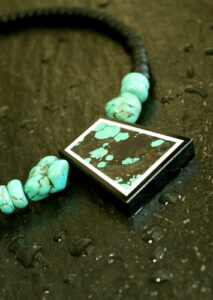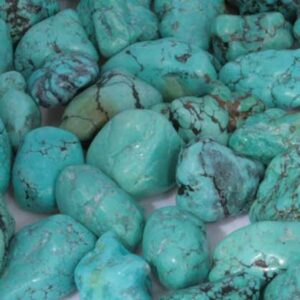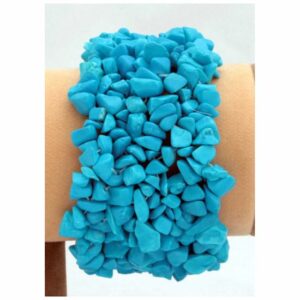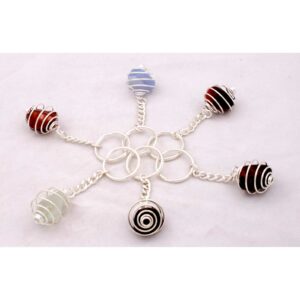
December’s Birthstone: Turquoise captivates with its blue-green hues and boasts a rich historical legacy.
Turquoise is also the gemstone for the 11th Wedding Anniversary.
Another gemstone associated with December is Lapis Lazuli.
December has a traditional flower associated with it, which is Ivy however the modern Flowers for December are Narcissus (Paperwhite), Holly and Poinsettia.
What Colour Is Turquoise?
Turquoise is an opaque gemstone that is known for its distinct blue-to-green colour and often has veins of the Matrix. The matrix refers to the host rock and appears as a web of cracks, veins, or blotches of varying colours that run through the Turquoise, making each stone unique.
Where Does The Word Turquoise Come From?
The word “turquoise” comes from the Old French adjective “turqueise,” which means “Turkish.” It was used to refer to stones (“pierre tourques,” which means “Turkish stone.”), that were originally brought to Europe from Turkish dominions. The stone was first traded through Persia and then to Europe, so it passed through Turkish hands and was called by the French name “Turkish stone,” and then the name stuck.
What Is The History And Symbolism of December’s Birthstone: Turquoise?
Turquoise has been prized for its beauty and significance for thousands of years. The stone has a rich history, with evidence of its use in several ancient civilisations, including ancient Egypt, Persia, and the Native American culture of the southwestern United States. The significance of turquoise varied within these cultures, but commonly it was regarded as a symbol of protection, luck, and healing.
In ancient Egypt, turquoise was believed to have protective powers and was associated with the goddess Hathor, who was the personification of love, beauty, music, dance, and motherhood. It was used to make jewellery and decorative objects, worn by pharaohs, and placed in tombs to protect the dead against evil spirits. In the Native American culture, turquoise is believed to have a powerful spiritual meaning, symbolising communication, fertility, and life force energy. It was used to make jewellery, amulets, and ceremonial objects. The Navajo tribe, in particular, regarded turquoise as a connecting force between the natural and the spiritual world.
Turquoise was also important in Persia, where it was used to adorn the sword handles, daggers, and bridles of high ranking officials. In medieval times, turquoise was thought to protect riders from falling off horses, prevent accidents, and ward off the evil eye. It was also believed to have medicinal properties and was used to treat a variety of ailments, including eye diseases, headaches, and breathing problems.
In modern times, Turquoise is still associated with its ancient meanings and is the birthstone for December. It’s been known to help strengthen personal relationships, improve communication, and aid in protection. In some cultures, those born in December also believe that their birthstone brings good fortune, happiness, and positivity to their lives.
What Are The Physical Properties Of Turquoise?
Turquoise is a fascinating gemstone with unique physical properties. The stone is known for its blue to green colour. It is generally opaque, although some specimens may have a translucent quality
In terms of its chemical composition, turquoise is a hydrated phosphate of copper and aluminium.
Turquoise has a relatively low hardness on the Mohs scale, ranging from 5 to 6.
The stone has a sub-vitreous to waxy lustre, giving it a soft and slightly glossy appearance.
Where Does Turquoise Come From?
Turquoise can be found in various locations around the world. In the United States, it is primarily found in the Southwest regions, with New Mexico and Nevada being the top producers. These locations offer different types of turquoise, each with its unique shade and pattern, making each piece of turquoise special.
Nevada, in particular, has a high density of turquoise mines, and many of them are not secondary sites to copper mining operations.
Apart from the United States, other notable sources of turquoise include Iran, Afghanistan, and China. Each of these regions has unique variations of the stone.
It’s important to note that the availability and quality of turquoise can vary over time and from one location to another. The market for turquoise also depends on factors such as mining operations and extraction techniques.
December’s Birthstone: Turquoise Gift Ideas.
Here are some turquoise gifts to consider:
Turquoise Jewellery:
Turquoise is most commonly used in jewellery, making it an excellent gift option. You can consider gifting a turquoise necklace, bracelet, bag charm, earrings, or a ring. Watches, keyrings and cufflinks make great gifts for the men in your life. There are various designs available, from modern and minimalist to intricate and traditional.
Turquoise Home Décor:

Turquoise can also be incorporated into home décor items. Consider gifting turquoise-coloured throw pillows, blankets, or rugs to add a pop of colour to someone’s living space. You can also find unique turquoise vases, candle holders, or wall art.
Turquoise Healing Stone:
Turquoise is believed to have healing and protective properties. Consider gifting a polished turquoise stone or a small turquoise crystal to someone who appreciates metaphysical properties. They can use it for meditation, energy balancing, or simply as a decorative item.
Turquoise Art or Crafts:
Turquoise-inspired artwork or crafts can make a thoughtful and unique gift. Look for paintings, sculptures, or handmade crafts that incorporate turquoise elements, such as turquoise-coloured pottery or mosaic art.
Its vibrant colour and symbolic meaning can add a touch of elegance and uniqueness to any gift.
-
 Turquoise Keychain£5.99
Turquoise Keychain£5.99 -
 Turquoise chip band Bracelet£8.39
Turquoise chip band Bracelet£8.39 -
 Gemstone Key ring Charm£5.99 – £9.95
Gemstone Key ring Charm£5.99 – £9.95
How To Care And Clean Turquoise Jewellery.
To care for and clean turquoise jewellery, it is important to follow these guidelines:
Avoid Excessive Exposure to Heat and Sunlight: Turquoise is sensitive to extreme heat and sunlight, which can cause discoloration or damage. It is best to store your turquoise jewellery in a cool, dry place away from direct sunlight.
Avoid Exposure to Chemicals: Chemicals found in household cleaners, perfumes, hairsprays, and lotions can potentially damage turquoise. It is advisable to remove your turquoise jewellery before using any household chemicals or engaging in activities that involve exposure to harsh chemicals.
Protect from Scratches: Turquoise is relatively soft and can be easily scratched, so it’s important to store your jewellery in a separate compartment or a soft pouch to prevent it from coming into contact with other harder gemstones or rough surfaces.
Clean Gently: To clean turquoise jewellery, use a soft, lint-free cloth or a microfiber cloth to gently wipe away any dirt or residues. Avoid using abrasive materials or brushes that can scratch the surface of the turquoise.
Avoid Excessive Moisture: It’s important to keep turquoise jewellery dry. Avoid submerging it in water or exposing it to excessive moisture, as this can potentially damage the stone or alter its colour.
Final Thoughts
In summary, turquoise is a captivating gemstone with a storied past. By understanding its properties, caring for it appropriately, and appreciating its significance, you can fully enjoy the beauty of turquoise.
To see other months see our the colourful world of birthstones page.




